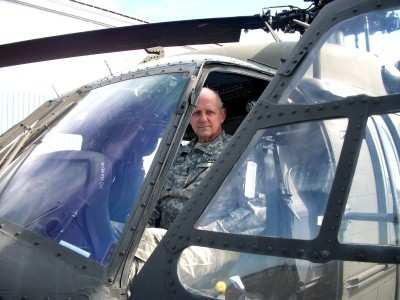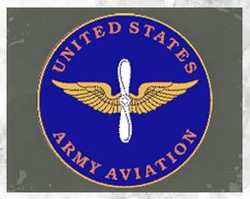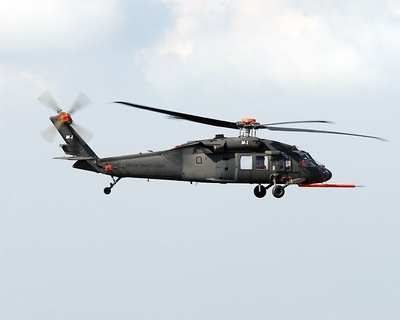Retiring With 21,000 Flying Hours Under His Rotary Wings
When Chief Warrant Officer Herb Dargue joined the Army as a
helicopter pilot, the Beatles' "Penny Lane" topped the charts, the
UH-1C Huey was the hottest "chopper" flying, and actor William
Shatner was "Star Trek's" Captain Kirk on prime time TV.
Forty-three years and 21,000 flying hours later, Dargue made his
last flight as a military aviator Friday. He's capping a career
that has included a year in Vietnam, another year in Iraq, and
service in the active Army, Army Reserve, and New York Army
National Guard.

Chief Warrant Officer Herb
Dargue
"It's the end of an era for this flight facility and this unit,"
said Army Lt. Col. Mark Slusar, commander of the 3rd Battalion,
142nd Assault Helicopter Battalion. "The lessons and the experience
this guy can pass on will be greatly missed." The unit plans to
mark Dargue's last flight -- after more than 5,300 hours of
military flight time -- with a fire truck salute and the
traditional champagne soaking when he steps out of a UH-60 Black
Hawk helicopter for the last time.
For Herb Dargue, flying is in the blood.
His grandfather, also named Herbert Dargue, became an Army pilot
in 1913, received the first Distinguished Flying Cross. Two weeks
after the attack on Pearl Harbor, he was flying to Hawaii to assume
command of some Army units based there when he died in a plane
crash. Dargue's father, Donald, was a B-17 bomber pilot in World
War II, was shot down, spent time as a German prisoner of war, and
then went on to serve in the Strategic Air Command.
Dargue ended up flying Army helicopters because the Air Force
wanted him to have a college degree, and back in 1967 the Army
didn't care. "I went to the recruiter's office in Patchogue," he
recalled. "I walked in the Air Force door and said, 'I want to
fly.' They said, 'Do you have a college degree?' I was a young
punk, 19 years old. I didn't want to finish college. I went next
door to the Army, and they signed me up."

In 1968, Dargue went to Vietnam where he flew Hueys for six
months with the 3rd Squadron, 17th Air Cavalry, and then six months
with a VIP transport unit. He left active duty in 1970 and joined
an Army Reserve aviation unit, flying everything from tiny OH-23
observation helicopters to the CH-47 Chinook. At the same time, he
pursued a career as a civilian pilot, flying traffic report
helicopters and charters of all kinds, before winding up in Iran in
1977, training Iranian army helicopter pilots. That job lasted for
two years until the Islamic revolution. He and the other
contractors were evacuated. "We were in the heat of battle getting
out of that place," Dargue said.
He moved back to New York in 1980, went to work for Island
Helicopter Corp., and joined the New York Army National Guard
helicopter unit at MacArthur Airport here. Since then, he has also
flown for Thompson Industries and most recently Lehmann Brothers,
while continuing to fly helicopters with the New York Army National
Guard.
In 2005, he deployed to Iraq as part of the 42nd Combat Aviation
Brigade. As an aviation liaison officer, he worked in the 42nd
Infantry Division Tactical Operations Center in Tikrit, tracking
Army flights across an area of Iraq the size of West Virginia. With
the 3-142nd deployed to Iraq in 2008 and 2009, Dargue got an
extension on his retirement date because the New York Army National
Guard needed experienced helicopter pilots at home, too.
His years of experience flying in New York City's congested
airspace have made him an invaluable asset to every pilot at the
Long Island Army Aviation Support Facility, said Slusar, his
battalion commander. "He just gave me my New York City orientation
last week," Slusar said. "He told me what was going to happen
before the tower would tell us."
Flying around New York is tricky, because there are so many
aircraft and so many airports, he explained. "You have to have
exact procedures. Otherwise, it creates chaos."

UH-60 File Photo
In his years as an Army pilot he's seen plenty of change, Dargue
said. The UH-60 has two engines, while the UH-1 had just one. And
Huey navigation, he said, was all dead-reckoning and looking out
the window and back at the map. Now, pilots have scrolling
electronic maps that tell them where they are.
And in combat now, helicopters always fly in pairs. "You're
never out there by yourself; you always have a wingman," Dargue
said. "In a lot of operations in Vietnam, you'd be out there by
yourself all alone."
Leaving the Army after so many years is "bittersweet," Dargue
said. He said he has loved military flying and the camaraderie, but
he knows it's time to leave. "All my peers have gotten out," Dargue
said. "It has a different atmosphere to it. The Vietnam vets, they
were just a little crazier than the generation nowadays -- a little
more fun. They're a little more business-like now. The atmosphere
is not the same."
 ANN's Daily Aero-Linx (04.16.24)
ANN's Daily Aero-Linx (04.16.24) Aero-News: Quote of the Day (04.16.24)
Aero-News: Quote of the Day (04.16.24) Airborne 04.10.24: SnF24!, A50 Heritage Reveal, HeliCycle!, Montaer MC-01
Airborne 04.10.24: SnF24!, A50 Heritage Reveal, HeliCycle!, Montaer MC-01 Airborne 04.12.24: SnF24!, G100UL Is Here, Holy Micro, Plane Tags
Airborne 04.12.24: SnF24!, G100UL Is Here, Holy Micro, Plane Tags Airborne-Flight Training 04.17.24: Feds Need Controllers, Spirit Delay, Redbird
Airborne-Flight Training 04.17.24: Feds Need Controllers, Spirit Delay, Redbird





